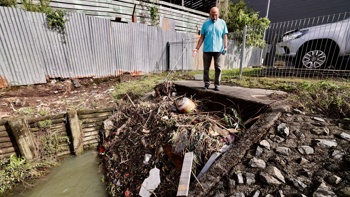WARNING: DISTRESSING CONTENT
An overseas pathology expert brought to New Zealand to testify for the defence in the ongoing murder trial of Dr Philip Polkinghorne said today he found it “quite mind-boggling to imagine” that the eye surgeon’s wife could have been manipulated after death to simulate a suicide by hanging.
“There is no evidence of a forensic pathology kind to positively support a conclusion that this deceased has been homicidally - manually or ligaturely - killed,” retired pathologist Stephen Cordner later concluded - his final words to jurors as he wrapped up a full day in the witness box answering questions from the defence.
Polkinghorne, now 71, is accused of having strangled Pauline Hanna, 63, inside their Remuera home before staging the scene on April 5, 2021, to look like a suicide by hanging. Two pathologists called by the Crown earlier in the trial have said both strangulation and hanging were possible explanations for her neck compression death.
Given the ambiguous pathology findings, the Crown has relied instead on circumstantial evidence - particularly regarding Polkinghorne’s allegedly significant methamphetamine habit and an alleged strangling threat in the past. Prosecutors have also focused on the defendant having spent hundreds of thousands of dollars on sex workers and his intimate messages with Sydney escort Madison Ashton in which the two appeared to be forming a serious relationship.
But the defence, which has now spent four days calling evidence, has described all that as a salacious distraction. The real issue, lawyer Ron Mansfield KC has said, is that Hanna had been struggling with depression and alcohol abuse for years. And she had been under immense work pressure as she helped manage the rollout of the Covid-19 vaccination, defence witnesses have said.
Today’s witness, now the third pathologist to enter the witness box, offered a more unequivocal opinion than those of his predecessors.
Cordner - a professor emeritus from the Department of Forensic Medicine at Monash University in Melbourne, a Member of the Order of Australia and the retired director of the Victorian Institute of Forensic Medicine, which is tasked with conducting the region’s autopsies - spent the first half of the day giving jurors an admittedly “pretty grim” primer on suicide, strangulation and how to detect both. Some of that background evidence has been suppressed to protect vulnerable members of the community, but the pathologist’s evaluation of Hanna’s death can be reported.
Polkinghorne said he found his wife in a chair in a position that has been described repeatedly as a “partial hanging”. He said he then untied the rope after calling 111 and receiving advice from the operator - who assumed it was a “full suspension hanging” - to cut her down. The defendant told police in an interview shortly after her death that he removed his wife’s body from the chair and placed her on the floor, propping a pillow under her head to make sure she was comfortable even though he knew she was dead.
Cordner asked jurors to consider an alternative theory that Hanna was placed in the chair and posed after a murder.
- Condition of Pauline Hanna’s body consistent with hanging, not strangulation - pathologist
- Jurors at Philip Polkinghorne murder trial view suppressed suicide research
- Engineer who conducted simulation of alleged suicide method gives evidence at murder trial
- Alibi or evidence tampering? Polkinghorne blood stain scrutinised at murder trial
- Power expert says washing machine didn't run morning of Hanna's death
- Polkinghorne's lawyer rips into 'intoxicated' police as defence takes the offensive at murder trial
“It really is quite mind-boggling to imagine that,” he said, because the “floppiness” of an unconscious or dead person makes the body very hard to manage. “It takes two people to successfully move a body.”
The lack of drag marks on the floor or on Hanna’s body are also factors that might weigh against a homicide, he said.
Lividity, or the settling of blood under gravity after a person’s death, was also analysed by the expert. Discolouration from the knees down suggested to Cordner that Hanna had been in a seated position sometime between death and when she was placed on the floor, he said. But the expert also emphasised to jurors that, on that particular issue, he didn’t want to sound as if “speaking from Mt Olympus”. Lividity, he explained, can be variable.
The recording made of Hanna by a relative when she visited their Hawkes Bay property, in which Hanna describes Polkinghorne as a 'sex fiend', was played to the jury in court.
The defence expert was asked to meticulously review each injury found in Hanna’s body during her autopsy.
There were “a couple of tiny, pinpoint abrasions” to the bridge of her nose, a series of four bruises on the back of her right upper arm and a single small bruise near her temple. All of the injuries he described as “trivial in any medical sense”, with no way of telling if they were the results of minor mishaps while alive or appeared after death.
The bruising on the arm “looks like a grip”, he acknowledged, but he noted it couldn’t be seen in a photo taken from the scene. That might suggest it was incurred after death, perhaps as authorities were moving the body.
“If it did happen in life, there’s more to discuss,” he added, giving an example of Hanna possibly having been steadied the night before after stumbling while intoxicated. While that’s just one random possibility, the injury does not justify an assumption it was “assaultive”, he said.
The same could be said for the bruise on Hanna’s forehead, which he acknowledged could have been the result of a punch but just as easily could have been a minor mishap or the result of post-death handling. All three pathologists agreed it was a “non-specific injury”, he pointed out.
It was perhaps more important in evaluating Hanna’s death, he said, to consider what was not found - specifically, injuries commonly associated with fatal stranglings.
Nail clippings taken during the autopsy showed no indication of scraping - either of herself or someone else. All of her acrylic fingernails were still attached at the scene, which Mansfield and the witness agreed was also of note.
“Presumably, if someone is fighting for their life ... they might be punching out or kicking out,” Mansfield said. “Did you see any of the types of ... clear defensive injuries indicating she was part of a struggle?”
The expert said he didn’t and pointed out that neither of the Crown experts did either.
“The number and distribution [of her injuries] does not allow the conclusion these injuries are the result of an assault,” Cordner said. “It’s about five injuries. I really want to be clear that we’re not in the ballpark of assaultive injuries...”
While it’s theoretically possible for there to have been a fatal strangulation that left no tell-tale injuries, “in practice, we don’t see it”, the expert said.
If someone was strangled with a ligature, “it’s going to be chaotic and hard fought and dynamic”, and in most cases, the ligature will be moving enough to cause abrasions, he said. Hanna did not have abrasions around her neck.
If she died via chokehold, where a person applies enough force to compress both the veins and the carotid artery, that also would likely result in some sort of external injuries, he said. And it would be similarly “absolutely expect to see abrasions or bruises” with manual strangulation using hands, he said.
“This is standard, un-exceptional forensic pathology,” the expert told jurors.
Defence lawyer Ron Mansfield KC did not finish questioning Cordner by the end of the day and prosecutors have not yet had an opportunity to cross-examine him. But he won’t return to the witness box until Friday, when the trial resumes.
Justice Graham Lang indicated to jurors earlier this week that they would have Thursday off.
READ LIVE UPDATES FROM TODAY’S HEARING
Craig Kapitan is an Auckland-based journalist covering courts and justice. He joined the Herald in 2021 and has reported on courts since 2002 in three newsrooms in the US and New Zealand.
The Herald will be covering the case in a daily podcast, Accused: The Polkinghorne Trial. You can follow the podcast at iHeartRadio, Apple Podcasts, Spotify, through The Front Page feed, or wherever you get your podcasts.
Take your Radio, Podcasts and Music with you









